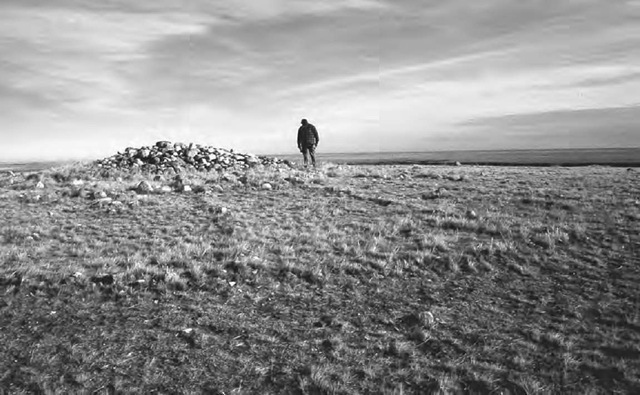The structures known as medicine wheels are distinctive configurations of boulders found across the Great Plains region of Canada and the United States. Over 130 examples are known; they are typically found in remote spots at high elevations. Among the most famous are Majorville Cairn in Alberta, Moose Mountain in Saskatchewan, and Big Horn in Wyoming. The archetypal medicine wheel is a few tens of meters (around a hundred feet) across and exhibits a characteristic “spoked wheel” structure, with an outer ring and a central cairn. In practice, however, no two are the same and the form varies widely. The supernatural and shamanic associations that have given rise to the term “medicine” are modern. Yet at sites such as Majorville, the large central cairn—striking both because of its size and because of the inclusion of a variety of colorful local stones topped with recent offerings—has evidently been cumulated over a very long period. Archaeological evidence corroborates this conclusion (the site was excavated in the 1970s) and demonstrates that there has been more or less continuous activity at the site for as long as five thousand years.
Medicine wheels were among the earliest indigenous structures in the Americas to be analyzed astronomically, at around the time of the rise of “megalithic astronomy” in Britain in the 1970s. Big Horn, for example, was found to have a plausible axis of symmetry oriented upon midsummer sunrise and excited much attention. This was followed by the discovery of alignments upon midsummer sunset and the rising positions of the stars Aldebaran, Rigel, and Sirius. The idea that these alignments could have been intentional was backed up by the common-sense argument that the heliacal risings of the three stars, and of course the summer solstice sunrise and sunset, all occurred during the summer months, when the site would not have been covered with deep, drifting snow.
Majorville medicine wheel, Alberta, Canada. The central cairn is an accumulation of boulders of many different types of brightly colored stone; the outer ring and some of the radial spokes are also visible.
However, as astronomical interest in medicine wheels grew, the ease with which solar, stellar, and even lunar alignments could be identified— and replaced by new ones when errors were found in earlier calculations— became disconcerting. A more systematic study in the 1990s by the Canadian archaeoastronomer David Vogt revealed little overall consistency in patterns of orientation and astronomical alignment. The basic problem was that the alignment hunters had paid little attention to the cultural context.
Anthropological studies have suggested a variety of functions that medicine wheels may have served: as monuments to the dead, for example; as focuses for Sun Dance rituals; or as sacred places where those on solitary Vision Quests went to seek the patronage of guardian spirits. Such ideas do not rule out the possibility that solar and stellar alignments were incorporated into at least some medicine wheels as a vital part of their broader function; but it is difficult to see any need for high precision, and the ways in which alignments were achieved are likely to have been as many and various as the different forms of the medicine wheels themselves.

